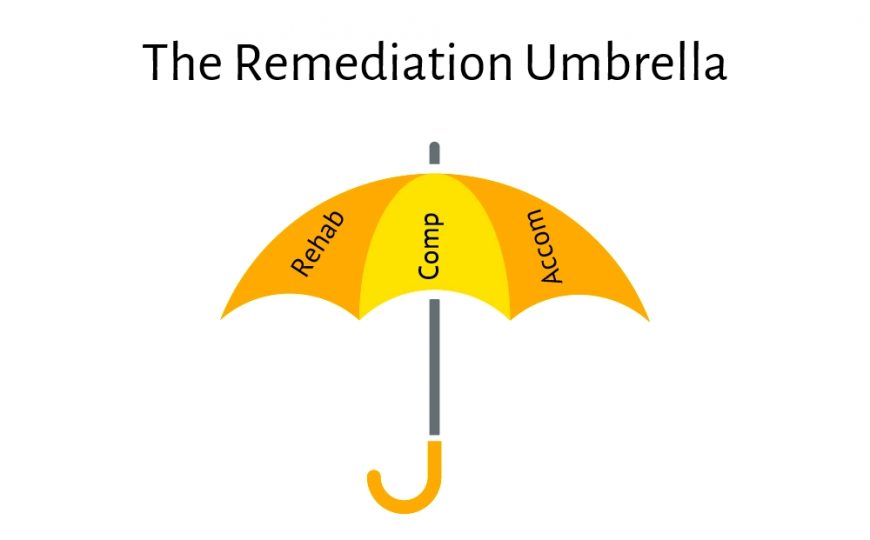You have a good differential diagnosis, now you need to figure out how to treat the problem.
We call this remediation. There are other terms that are used interchangeably, which leads to confusion as each term has its own meaning. Here I will clarify. Consider Remediation the overarching plan to treat the problem, one that has different spokes, or parts, to it.
There are three branches to remediation:
1) Rehabilitation
2) Compensation
3) Accommodation
Rehabilitation is the work we do to strengthen or fix the weak area. This may mean a corrective surgery, exercises or simply time to recuperate.
Compensation is the work we do using a strength to bypass the weak area. Using a tactile alphabet system so that a blind person can read is an example in which we bypass sight using the sense of touch instead. What is important to appreciate here is that this is only a good compensatory strategy if the tactile system is a strength. If someone had Cerebral Palsy or some other condition in which they could not rely on touching the braille then this would not be a good strategy, no matter how many other blind people it worked for. For a hearing-impaired person, we may use a teletypewriter (TTY) a.k.a. telecommunications device for the deaf (TDD) phone to converse. This bypasses the hearing-impaired person’s need to hear the phone conversation, allowing them to read instead.  (This technology predates texting and has been around since the mid 60’s). This is only a good strategy if this individual can read the text. This obviously would not be a good strategy for someone who is illiterate or too visually impaired.
(This technology predates texting and has been around since the mid 60’s). This is only a good strategy if this individual can read the text. This obviously would not be a good strategy for someone who is illiterate or too visually impaired.
Accommodation is when we place the burden on another to change something or make allowances for the handicap to make access easier for the handicapped person. This may mean a ramp or elevator access for someone who has mobility limitations, allowing a service animal in a pet free area or an interpreter when someone does not speak the language (including a sign language interpreter for a Deaf person). An IEP may specify that the teacher make a change to her instruction method, class environment, the tests or responses required for our handicapped student. These changes need to be individualized for the student’s particular handicap.
Which of these three branches of remediation should you focus on and how much? This needs to be determined on a case by case basis depending on the areas of life impacted by the handicap and the resources available. ![]() You need to consider resources available and ROI. Whenever possible it is always best to rehabilitate. This allows the person improved function in any and all areas affected by the handicap.
You need to consider resources available and ROI. Whenever possible it is always best to rehabilitate. This allows the person improved function in any and all areas affected by the handicap.
Sometimes you need to rehabilitate and compensate simultaneously. For example, a child is not reading like his peers. A good differential diagnosis was done and it is discovered he has an auditory processing disorder. Supposing his particular manifestation of APD is slow processing speed. This can rehabilitateable and it will be very beneficial to do so. However, this child is 9 years old and is too far behind in reading to wait for the completion of treatment for the auditory disability to only then address the reading issue. You might want to simultaneously teach him reading using a compensatory method that does not rely so heavily on the auditory system to learn this skill. There is a reason there are over a dozen reading methods. Each was developed because the existing methods were found not work for a particular profile so a new method evolved. Different methods are best suited for different disability profiles in combination with different strengths. ![]() You improve your ROI when you know the strength and weakness you are dealing with and how well the mechanism the remediation is being delivered through aligns with this profile.
You improve your ROI when you know the strength and weakness you are dealing with and how well the mechanism the remediation is being delivered through aligns with this profile.
Next time: A word of caution in planning remediation.
Best,
![]()



